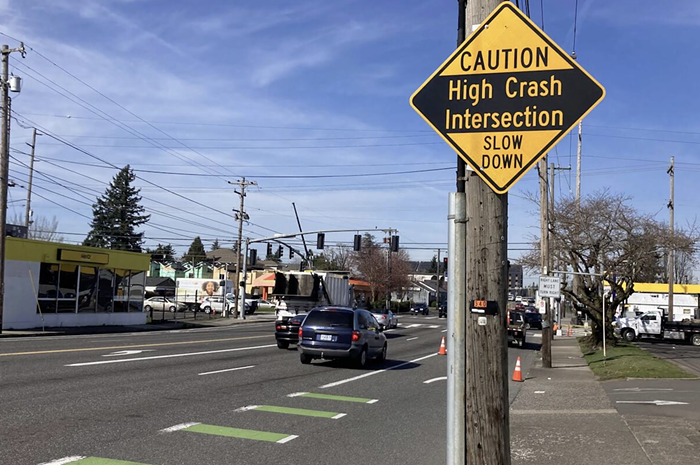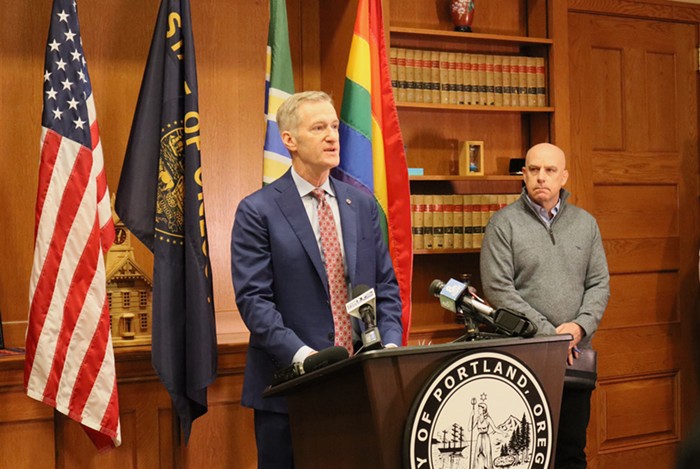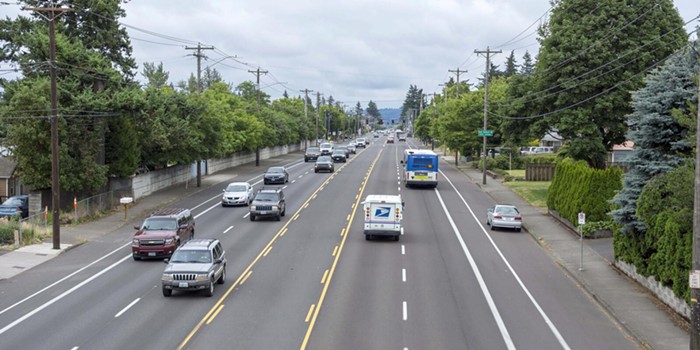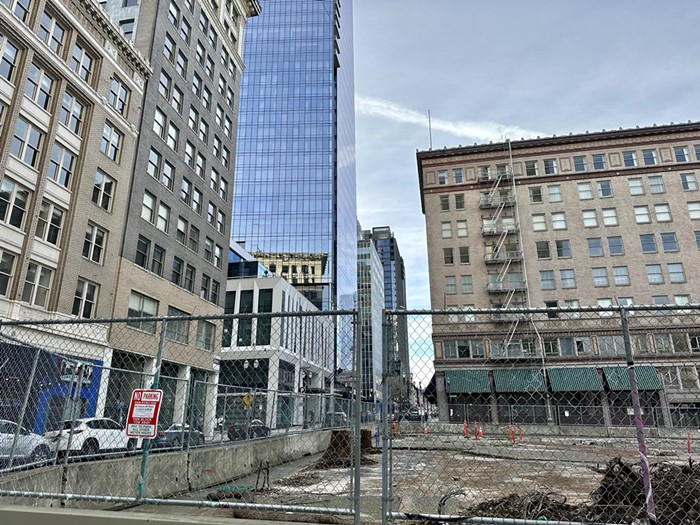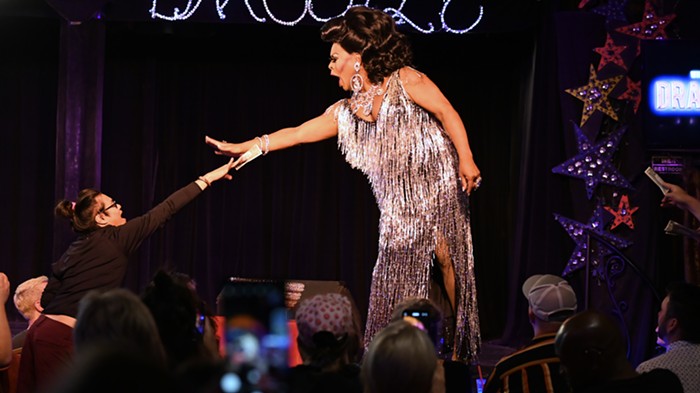POLICE COMMANDERS reviewing the chaotic aftermath of a homeless camp sweep beneath the Morrison Bridge last October all agreed on one thing: Officer Todd Engstrom made a mistake.
By suddenly grabbing a camper's dog—which had been running loose, but not menacing anyone—Engstrom turned an already tense confrontation into something violent. The campers exploded in anger, forcing cops to form a defensive line. Engstrom, the particular target of the rage, eventually decided he had no other recourse than to unload pepper spray into at least two people's faces.
If Engstrom hadn't gone for the dog, an internal investigation found, the whole encounter might have concluded with minimal fuss. But police commanders, when it came time to hand out discipline, made a crucial distinction.
The veteran cop—named in a complaint by one of the pepper-sprayed campers, Angel Lopez—was punished only for escalating the confrontation. The actual use of the pepper spray to subdue an angry crowd (never mind how the crowd became that way) was ruled within policy.
That wasn't good enough for Lopez, who appealed to the Citizen Review Committee (CRC), a volunteer panel tasked with reviewing police misconduct investigations. And the committee agreed—setting up a potential showdown with police brass.
The panel voted 6-1 last Wednesday, August 6, to challenge the bureau's finding that Engstrom did nothing wrong when he sprayed both Lopez and his girlfriend.
According to records kept by Portland Copwatch, this case marks the third time since August 2013 that the CRC has asked Police Chief Mike Reese to punish a cop he'd previously decided to clear.
Reese persuaded the panel to back off in the first case, exploiting a close vote. He eventually agreed the second time, faced with a unanimous decision, after originally saying no and then changing his mind after the cop in question resigned.
This case also involves heavier stakes: It's the first time in more than four years that the CRC has demanded punishment over the use of force. The last time was in February 2010, when the CRC asked then-Chief Rosie Sizer to punish Officer Ron Frashour for improperly Tasering a man named Frank Waterhouse in 2006.
Sizer refused at first, relenting only after the CRC voted to send the case to Portland City Council. Engstrom's case, if Reese stays the course, would be the second from the CRC to go before council, says Dan Handelman of Portland Copwatch.
That's not the only fault line in play.
Engstrom's case spills directly from the police bureau's evolving approach to homelessness and nuisance crimes. As the Mercury first reported in February, Lopez was among a handful of campers mistakenly targeted for sidewalk violations under an enforcement policy that was supposed to curb crimes like littering and public intoxication ["Bending the Law," News, Feb 26].
It also reflects one of the findings in a nearly two-year-old federal complaint against the Portland Police Bureau—which produced a settlement agreement of reforms that has yet to be accepted by a federal judge.
In accusing Portland officers of engaging in a pattern or practice of using excessive force against people with mental illness, the US Department of Justice also found Portland officers were sometimes prone to using force in encounters when it might otherwise have been avoided.
Part of the bureau's reform plan now includes grading officers on the decisions they make before force is used.
Lopez's complaint to the city's Independent Police Review Division took weeks longer than usual to investigate, in part because of the sheer number of witnesses. Video captured by two campers, shown prior to the CRC vote, shows several campers, cops, and private security guards. Everyone had a slightly different version of the events—not uncommon in police reports and interviews in such cases.
Engstrom was a familiar face for the crowd under the bridge, including Lopez. Documents obtained this year by the Mercury show Engstrom participating in several warnings and arrests directed at Lopez for the charge of interfering with a police officer—the main enforcement tool cops improperly applied to sidewalk violations under the Chronic Offender Pilot Project.
In his interview with police investigators, Engstrom tried to explain why he went after the dog—the spark that set everything else off.
The dog didn't have a leash and might have run into traffic or bit someone, he said—though he also said he didn't think the dog would bite him. It did, but only after he spooked it by grabbing for its collar. Bleeding from the bite, Engstrom took the dog by the scruff of its neck and threw it to the ground, kneeling on it.
Told that a sergeant at the scene had written a report suggesting Engstrom fouled up by agitating the dog, he relented and "acknowledged that it probably would have been smarter to leave the dog alone," according to a public summary of the investigation.
By then, it was too late. Engstrom could hear the crowd shouting that he was trying to kill the dog. The other cops formed a protective line that Engstrom joined as soon as another sergeant came over with a dog pole and relieved him.
That's when Engstrom says he saw Lopez "violently" shove another officer, Michael Bledsoe, who'd been trying to keep Lopez back. Without warning, Engstrom took out his pepper spray and nailed Lopez in the face. He also said he'd silently decided—conveniently just before deploying the spray, he told investigators—that he wanted to arrest Lopez.
Which is why, he said, he sprayed Lopez's girlfriend soon after. She was grabbing onto Lopez, he said, and trying to pull him away from the line of cops—never mind that Engstrom hadn't said that Lopez was under arrest. Only later, after spraying Lopez one more time and threatening others, did Engstrom make that clear.
The funny thing about Engstrom's memory, though, is that the encounter between Bledsoe and Lopez wasn't nearly as "violent" as he described it. Bledsoe told investigators he'd used a closed fist to push an angry Lopez back—and that all Lopez had done was slap his hand away. No other officer thought to bring out the pepper spray because of what Lopez had done—a point CRC member Jeff Bissonnette made when discussing the case.
Asked about that disconnect at the hearing, the supervisor who'd backed Engstrom's use of pepper spray said it didn't matter. Any contact with Bledsoe was sufficient.
"He struck his hands away," acting Captain Mathew Wagenknecht said. "It's a hit."
Wagenknecht was also asked repeatedly why Engstrom's use of force would be okay given that the actions leading up to it weren't.
"Even though he didn't like what the officer did," he answered, "[Lopez] still doesn't have the right to push or assault. We had to separate the two incidents, in my mind."
The CRC's mandate is fairly limited. If a commanding officer's discipline ruling is supported by logic, then the CRC members aren't supposed to challenge it—even if they don't agree with it. That might have kept them from challenging the bureau's decision to clear Engstrom—if the complaint about pepper spray was only about Lopez.
The clincher, for most CRC members, was that it wasn't. They quickly found themselves focusing on Engstrom's decision to spray Lopez's girlfriend. Tugging on someone who hasn't been told he's been arrested, no matter what an officer has privately decided, is hardly a threat, CRC members argued. It's the opposite.
"He has it in his mind he's arresting the appellant," Bissonnette said. "But nobody else knows that. She certainly doesn't know that. She's trying to get him back. The spray enraged him even more. She's trying to do her part not to help him escape but to defuse the situation."

